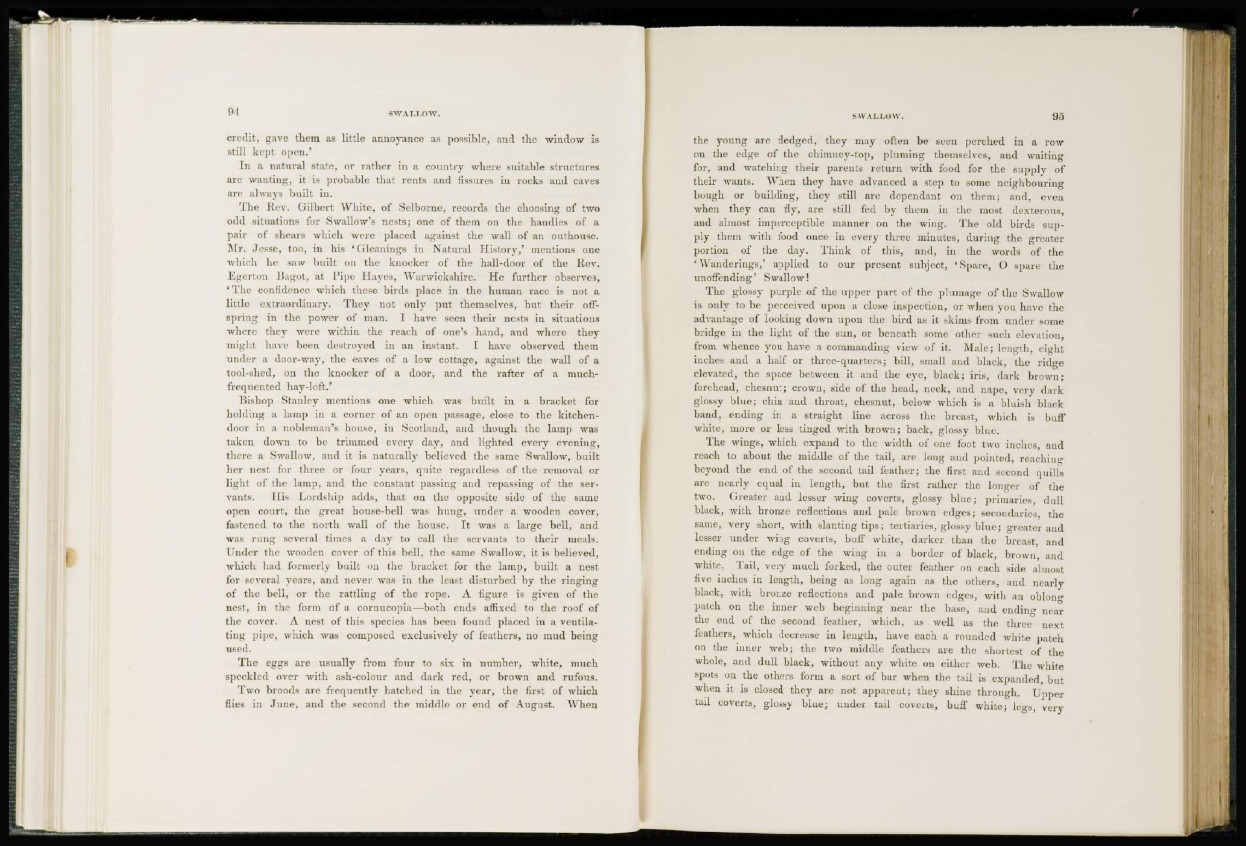
credit, gave them as little annoyance as possible, and the window is
still kept open.'
In a natural state, or rather in a country where suitable structures
are wanting, it is probable that rents and fissures in rocks and caves
are always built in.
The Rev. Gilbert White, of Selborne, records the choosing of two
odd situations for Swallow's nests; one of them on the handles of a
pair of shears which were placed against the wall of an outhouse.
Mr. Jesse, too, in his 'Gleanings in Natural History,' mentions one
which he saw built on the knocker of the hall-door of the Rev.
Egerton Bagot, at Pipe Hayes, Warwickshire. He further observes,
'The confidence which these birds place in the human race is not a
little extraordinary. They not only put themselves, but their offspring
in the power of man. I have seen their nests in situations
where theyr were within the reach of one's hand, and where they
might have been destroyed in an instant. I have observed them
under a door-way, the eaves of a low cottage, against the wall of a
tool-shed, on the knocker of a door, and the rafter of a muchfrequented
hay-loft.'
Bishop Stanley mentions one which was built in a bracket for
holding a lam]) in a corner of an open passage, close to the kitchendoor
in a nobleman's house, in Scotland, and though the lamp was
taken down to be trimmed every day, and lighted every evening,
there a Swallow, and it is naturally believed the same Swallow, built
her nest for three or four years, quite regardless of the removal or
light of the lamp, and the constant passing and repassing of the servants.
His Lordship adds, that on the opposite side of the same
open court, the great house-bell was hung, under a wooden cover,
fastened to the north wall of the house. It was a large bell, and
was rung several times a day to call the servants to their meals.
Under the wooden cover of this bell, the same Swallow, it is believed,
which had formerly built on the bracket for the lamp, built a nest
for several years, and never was in the least disturbed by the ringing
of the bell, or the rattling of the rope. A figure is given of the
nest, in the form of a cornucopia—both ends affixed to the roof of
the cover. A nest of this species has been found placed in a ventilating
pipe, which was composed exclusively of feathers, no mud being
used.
The eggs are usually from four to six in number, white, much
speckled over with ash-colour and dark red, or brown and rufous.
Two broods are frequently hatched in the year, the first of which
flies in June, and the second the middle or end of August. When
the young are fledged, they may often be seen perched in a row
on the edge of the chimney-top, pluming themselves, and waiting
for, and watching their parents return with food for the supply of
their wants. When they have advanced a step to some neighbouring
bough or building, they still are dependant on them; and, even
when they can fly, are still fed by them in the most dexterous,
and almost imperceptible manner on the wing. The old birds supply
them with food once in every three minutes, during the greater
portion of the day. Think of this, and, in the words of the
'Wanderings,' applied to our present subject, 'Spare, O spare the
unoffending' Swallow!
The glossy purple of the upper part of the plumage of the Swallow
is only to be perceived upon a close inspection, or when you have the
advantage of looking down upon the bird as it skims from under some
bridge in the light of the sun, or beneath some other such elevation,
from whence you have a commanding view of it. Male; length, eight
inches and a half or three-quarters; bill, small and black, the ridge
elevated, the space between it and the eye, black; iris, dark brown;
forehead, chesnut; crown, side of the head, neck, and nape, very dark
glossy blue; chin and throat, chesnut, below which is a bluish black
band, ending in a straight line across the breast, which is buff
white, more or less tinged with brown; back, glossy blue.
The wings, which expand to the width of one foot two inches, and
reach to about the middle of the tail, are long and pointed, reaching
beyond the end of the second tail feather; the first and second quills
are nearly equal in length, but the first rather the longer of the
two. Greater and lesser wing coverts, glossy blue; primaries, dull
black, with bronze reflections and pale brown edges; secondaries, the
same, very short, with slanting tips; tertiaries, glossy blue; greater and
lesser under wing coverts, buff white, darker than the breast, and
ending on the edge of the wing in a border of black, brown, and
white. Tail, very much forked, the outer feather on each side almost
five inches in length, being as long again as the others, and nearly
black, with bronze reflections and pale brown edges, with an oblong
patch on the inner web beginning near the base, and ending near
the end of the second feather, which, as well as the three next
feathers, which decrease in length, have each a rounded white patch
on the inner web; the two middle feathers are the shortest of the
whole, and dull black, without any white on either web. The white
spots on the others form a sort of bar when the tail is expanded, but
when it is closed they are not apparent; they shine through. Upper
tail coverts, glossy blue; under tail coverts, buff white; lugs, very